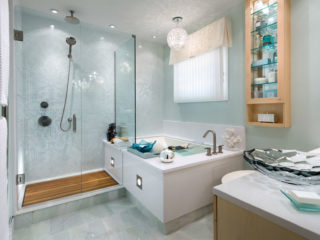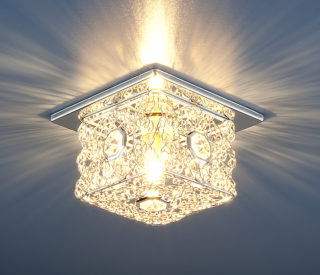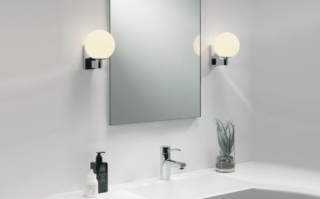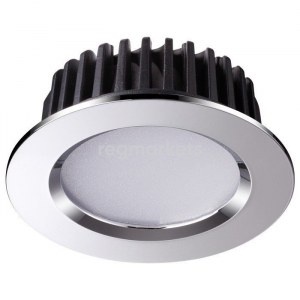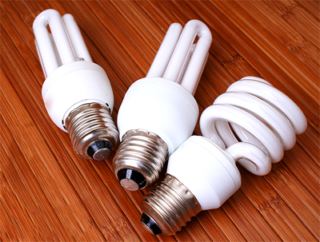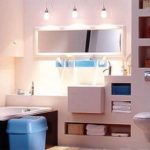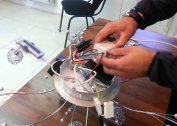Conventional appliances are not suitable for lighting a bathroom, as this is a room with a high level of moisture, which can be life threatening. Also, the bathroom has no windows, therefore, sunlight does not enter there, so you need to properly place the lamps so that it is convenient to use all plumbing devices. In the new decorated room, it is important to harmoniously enter electrical appliances in style and color - this will help the consultation of the designer.
What to consider when choosing appliances
First of all, you need to pick up the lamps in the bathroom, taking into account the safety requirements and the method of fastening. Typically, the wiring is mounted at the stage of rough repair, if there is a ready-made plan for the placement of devices. But it so happens that the residents do not take this moment into account and the lamps have to be plugged into the outlet. The disadvantage of this method is hanging wires, which can ruin the interior.
Safety
Ordinary room lights differ from those installed in the bathrooms, the internal device. They have additional parts that block water and steam from accessing bare wires, terminals, a lamp holder — to the entire electrical unit.
In the place where the wiring enters the lamp housing, there is a rubber gasket (or plug). The same thing - at the junction of the cartridge with the electrical unit. You can find out whether the lamp is suitable for the bathroom or not, according to the accompanying documentation, where the manufacturer indicates the moisture protection parameters. This is the IP degree, the index of which begins with the number 24 and ends with 68. In the first case, this is the minimum protection indicator, in the second, the maximum. In addition to protection against moisture, there is also a degree of dust protection, but this parameter does not so significantly affect the safety of people in the bathroom.
Placement separation
Of course, devices with the maximum degree of protection are more expensive, so they are chosen as the lamp is located close to the water source. To do this, the room is conditionally divided into 3 zones:
- It is located directly above the plumbing fixtures - a bathtub, shower or sink, where humidity is close to one hundred percent. Here the degree of protection should be maximum.
- At a distance of 30 to 60 cm, where splashes from water can get. Powerful lamps are not used here, and the degree is selected at least 45.
- Located at a distance of more than 60 cm from the end of the second zone. Luminaires with minimal IP protection are suitable for it.
Condensation is a hazard. The area where the drops will be collected should be equipped with devices with the maximum degree of protection. It is important here whether there is ventilation in the room and how effective it is.
Design
The main requirement for the design of the bathroom is that the lamps, tiles, sanitary ware and furniture are in harmony with each other, creating a single whole in perception. If tiles and furniture are designed in one style, and lamps in another, a sense of integrity will not arise, and the look will always dwell on those details that do not fit into the interior.
It may be a designer’s mistake to select too simple lamps relative to other style elements, or vice versa, too bright or defiant. For interior design it is better to use the services of professional designers.
How the illumination of the bathroom is calculated
The unit of measurement for the degree of illumination is lux, abbreviated lx.- 1 lumen per square meter. The required degree for the bathroom, SanPin defines as 50 lux. The space near the washbasin is at least 100 lux. This applies to fluorescent lamps. Incandescent lamps have other requirements: at least 20 lux, near the washstand - 50 lux.
Lighting calculation is affected by:
- number of devices (N);
- their power (p);
- floor area (S).
Using the formula P = p X S / N, you can determine if there is enough power if you take the minimum power of 20 watts for "p". If you need more light or if people with low vision are in the room, then a "p" is taken at least 30 watts.
When choosing lighting, you need to consider the type of finish. Light tile or plaster reflects light better, so you can do with fewer appliances or less power. With a dark tile - on the contrary.
A large number of mirrors or glossy stretch ceilings increase the amount of light.
When installing LED lamps, the calculation is done according to a different scheme. For example, one 100-watt incandescent lamp gives the same light flux as several LEDs at 1200 lumens.
Types of fixtures for the bathroom
All lamps in the bathroom can be divided into ceiling, wall, floor lighting.
The main task of all light sources is to organize high-quality lighting of individual zones. Ceiling models include chandeliers, diode tapes, panels, overhead and spotlights.
Ceiling models
Chandeliers are suspended structures that are suitable for rooms with high ceilings and a specific style of furniture. Most often used in classic bathroom designs. At the same time, the room should be large enough and spacious so that a lamp of this type does not seem too bulky.
LED strips are used in complex ceilings with several levels to create unusual lighting for the main devices. Plus tapes - the ability to combine several color shades. Usually located under baseboards.
The light panel is distinguished by the complexity of the configuration and combination of various types of lighting devices, which allows you to create interesting design solutions. To avoid frequent problems with replacing burned out lamps, you can not save on their quality, otherwise you will have to dismantle all or part of the structure.
Overhead lights are a bracket with several fixtures that can be rotated to illuminate the desired object. Thus, the most significant parts of the interior can be distinguished, emphasizing their beauty.
The location of spotlights is negotiated in advance, at the stage of rough work. Lamp groups can be switched on individually or all together. To do this, equip the switch, the buttons of which are responsible for each group of devices.
Wall mounted appliances
Wall lights include wall lights and spots (overhead lights). Sconce - several devices of the same type on one bracket. Most often used to illuminate mirrors on top or sides.
Overhead spots are attached in any convenient way - vertically or horizontally. They are usually installed close to the wall. The plus is that this model takes up little space and is suitable for small rooms with low ceilings.
Floor models
Floor lamps include floor lamps, but they give a dim beam of light, therefore they cannot be used for the entire bathroom - only for any one niche. In addition, the installation of a floor lamp requires more space, which is not always possible in a small apartment.
Some models are designed for installation in the floor, most often they are combined with glass tiles or floor panels. This design nuance limits the scope of such devices. Although in practice it is a very convenient solution to avoid obstacles.
Luminous tiles are an economical way to illuminate a bathroom, as it is independent of electricity. On the other hand, it cannot be turned off, since the materials used for this purpose have a glow effect.
Lamps for slatted and stretch ceilings
A stretch ceiling is a film that is located about 3-5 cm below the main ceiling. Therefore, it is possible to install spotlights and their varieties - built-in, overhead and semi-mortise, as well as LED strips and chandeliers, spots and track systems. In terms of mounting reliability, these models do not cause problems. They usually try to select the power of halogen lamps no higher than 30 watts. LED and fluorescent fit everything. When using incandescent lamps, it is necessary to ensure that the distance to the film is at least 30 cm.
When installing pendant lights, the heating part is located far from the film, so it does not overheat and does not deform.
There is a desire to install square spotlights to illuminate the bath: under them there should be a platform of a special size. This must be agreed upon when buying a ceiling and choosing lighting fixtures, otherwise the order will be very expensive.
Features of embedded and overhead models
Fixtures in the ceiling in the bathroom, you can choose built-in or overhead. Which type of installation to choose depends on such factors:
- type of ceiling;
- repair stage;
- installation cost.
In built-in models, the electrical unit is completely in drywall or behind the film. The outer part is level with the ceiling or slightly protrudes. Such devices visually save space, make it wider and higher. For installation, it is necessary to prepare the holes of the required size, which are indicated in the instructions. The direction of light is vertical, occasionally there are models that have an adjustable module capable of turning the lamp.
For overhead appliances, it is not necessary to have a margin of distance between the base ceiling and the suspended ceiling. Also, they do not need special installation preparatory work. There are models of various shapes, colors and materials, which makes them universal.
Which lamp to choose - built-in or laid on - depends on the method of fixing the ceiling (there may not be enough space to hide the built-in electrical unit), as well as the style features of the room.
Rotary and rotary devices
By design, spotlights are rotary and non-rotary. Rotary can be directed in any direction, non-rotary always shine in one direction, for example, if they are located on the ceiling, then only down.
Swivel models are most often mounted on special brackets. With their help, you can create any configuration of lighting in the apartment. Fixed ones are likely to be mounted in a suspended or plasterboard ceiling.
Varieties of lamps for fixtures
The bathroom has cosmetic procedures, so the lighting, especially near the mirror, should be maximum. This indicator depends on the variety of lamps, each of which has its own advantages and disadvantages. On sale you can find:
- LED lamp;
- luminescent;
- halogen;
- incandescent.
LED lamps are considered environmentally friendly, because they do not contain harmful evaporated impurities of metals, such as mercury. They give bright light, so they need less to illuminate the room. There are tape lamps that are convenient to place on various bends of the wall. The filling of the LED lamp is resistant to voltage surges, so it lasts longer. Energy consumption is lower - they save money during operation. The only negative is that they are expensive.
Luminescent give a bright light and serve twice as long as an incandescent lamp. At the same time, they warm up for a long time and fail with frequent voltage drops. They are more toxic, therefore they are used with additional safety measures.
Halogen lamps are beams of light that are often used in basic lighting. If you use only halogens, the room will have partial shade, which is not always convenient for face care - shaving, peeling. Lamps react strongly to voltage fluctuations, so a stabilizer must be in the house so that the lighting fixtures last longer. For financial investments, it comes out more expensive.
Conventional incandescent lamps are short-lived, in addition, the body may melt due to overheating and large heat transfer.
Fixtures in the interior of the bathroom
For some people, taking a bath is a kind of ritual that helps to relax and abandon everyday worries. Therefore, it is important to create such lighting that will not be evident. A multi-level backlight system is best suited for this. If you need full light, turn on all the lamps; if not, they are limited to LED strip or light panels.
Also, bulbs can be installed in furniture - bedside tables, cabinets where bathing accessories are stored. This will allow you to quickly find the right things. The main requirement is functionality and security. It is not advisable to overload the bathroom with high-power lighting. For this, economical lamps are selected.
Location of light sources
Thanks to various combinations of lighting devices, any configuration of the main and zone light can be created. Selecting different capacities, it is possible to highlight functionally important areas - a sink, furniture or decorative interior items.
There are lamps on flexible brackets that can be turned and directed in any direction, while there is no need to install several devices instead of one universal. This will save on electricity and at the same time will be a practical solution.
The nuances of installing fixtures in the bathroom
 The first step is to determine where to route the cable and in what place to bring it out for connection, how many such points should be in the bathroom. Typically, devices are placed in a certain order, so places are marked with a marker.
The first step is to determine where to route the cable and in what place to bring it out for connection, how many such points should be in the bathroom. Typically, devices are placed in a certain order, so places are marked with a marker.
It is important what type of cable will be used. You can’t save on such details, since damage to poor-quality wires threatens to completely destroy the finish of the bathroom in order to replace the site. It is recommended to take a single-core copper wire. It must be isolated. To do this, use the strobing technique, where a corrugation with several wires is laid.
All materials must be moisture resistant, and devices selected according to the IP security system as they move away from water sources.
Installation can be carried out independently if the landlord has knowledge in the field of electrical. Otherwise, it is better to call the masters - they will do the job faster and better. Licensed companies give a guarantee for their work. In case of any malfunctions, you can contact them with a request to correct the work.




